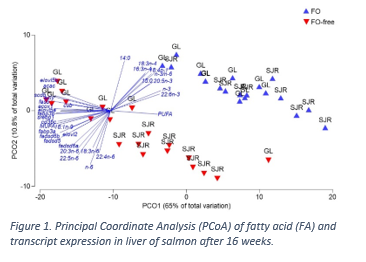FRESHWATER, LANDLOCKED GRAND LAKE STRAIN OF ATLANTIC SALMON Salmo salar L. AS A POTENTIAL GENETIC SOURCE OF LONG CHAIN POLYUNSATURATED FATTY ACIDS SYNTHESIS
Selection efforts focused on adaptation to plant-based diets, particularly the ability to synthesize polyunsaturated fatty acids (PUFA), are now emerging in aquaculture. Landlocked salmon (Grand Lake population; GL) may differ from the commercial Saint John River (SJR) strain in terms of PUFA metabolism. The objective of this study was to determine if landlocked GL strain have a better capacity to synthesize and store n-3 LC-PUFA, in the absence of dietary fish oil, in comparison to the SJR strain.
A 2x2 factorial trial was designed using two feeds containing fish oil (FO) or plant-based oil (FO-free) and was tested over 16 weeks in the SJR and GL strain (58 g/fish). Transcript
levels of lipid metabolism-relevant genes, FA content of liver and
muscle, and fish growth were determined.
GL salmon fed the FO diet showed reduced growth compared to SJR salmon (fed either diet); however, for GL salmon fed the FO-free diet, growth was not different compared to any group.
In liver, SJR salmon fed the FO-free diet had higher levels of n-6 PUFAs (21.9%) compared to GL fed the same diet (15.9%); while GL salmon fed the FO-free diet had higher levels of monounsaturated FAs (48.9%) compared with SJR salmon fed the same diet (35.7%). 20:5n-3 and 22:6n-3 were the
same in GL and SJR liver and muscle
fed the FO-free diet.
In liver, the GL strain fed the FO-free diet appeared to show higher expression levels of transcripts
involved in de novo FA synthesis (acac and acly) . The two strains also showed different strategies to balance n-3 and n-6 FA to control inflammation . However, synthesis and storage of EPA and DHA in the muscle tissue was not different between strains when they were fed the FO-free diet.
Our study clearly indicates that both the SJR strain and the GL strain responded differently to the FO-free diet compared to the FO diet. These results suggest there is a genetic basis behind the potential for GL salmon to utilize FO-free diets more efficiently than SJR salmon, with regards to FA metabolism.
